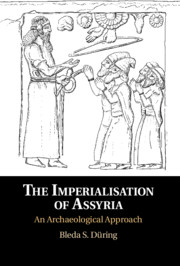
-
Select format
-
- Publisher:
- Cambridge University Press
- Publication date:
- January 2020
- January 2020
- ISBN:
- 9781108778701
- 9781108478748
- Dimensions:
- (253 x 177 mm)
- Weight & Pages:
- 0.6kg, 198 Pages
- Dimensions:
- Weight & Pages:
- Subjects:
- Ancient History, Classical Studies
You may already have access via personal or institutional login- Subjects:
- Ancient History, Classical Studies
Book description
The Assyrian Empire was the first state to achieve durable domination of the Ancient Near East, enduring some seven centuries and, eventually, controlling most of the region. Yet, we know little about how this empire emerged from a relatively minor polity in the Tigris region and how it managed to consolidate its power over conquered territories. Textual sources, often biased, provide a relatively limited source of information. In this study, Bleda S. Düring examines the rich archaeological data of the early Assyrian Empire that have been obtained over the past decades, together with the textual evidence. The archaeological data enable us to reconstruct the remarkably heterogeneous and dynamic impact of the Assyrian Empire on dominated territories. They also facilitate the reconstruction of the various ways in which people participated in this empire, and what might have motivated them to do so. Finally, Düring's study shows how imperial repertoires first developed in the Middle Assyrian period were central to the success of the Neo-Assyrian Empire.
Contents
Metrics
Altmetric attention score
Full text views
Full text views help Loading metrics...
Loading metrics...
* Views captured on Cambridge Core between #date#. This data will be updated every 24 hours.
Usage data cannot currently be displayed.
Accessibility standard: Unknown
Why this information is here
This section outlines the accessibility features of this content - including support for screen readers, full keyboard navigation and high-contrast display options. This may not be relevant for you.
Accessibility Information
Accessibility compliance for the PDF of this book is currently unknown and may be updated in the future.


